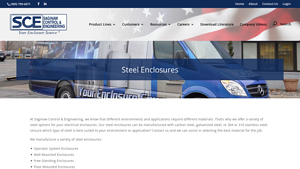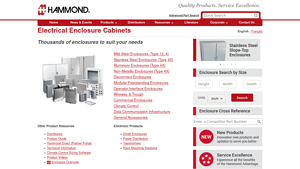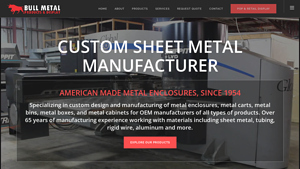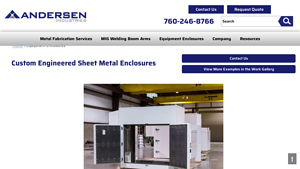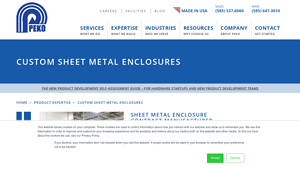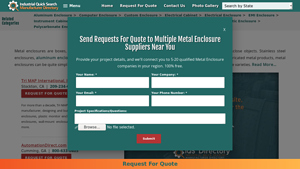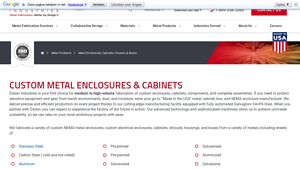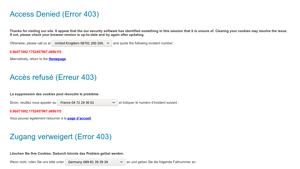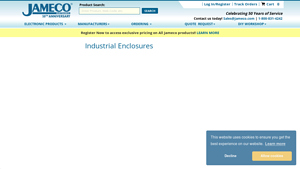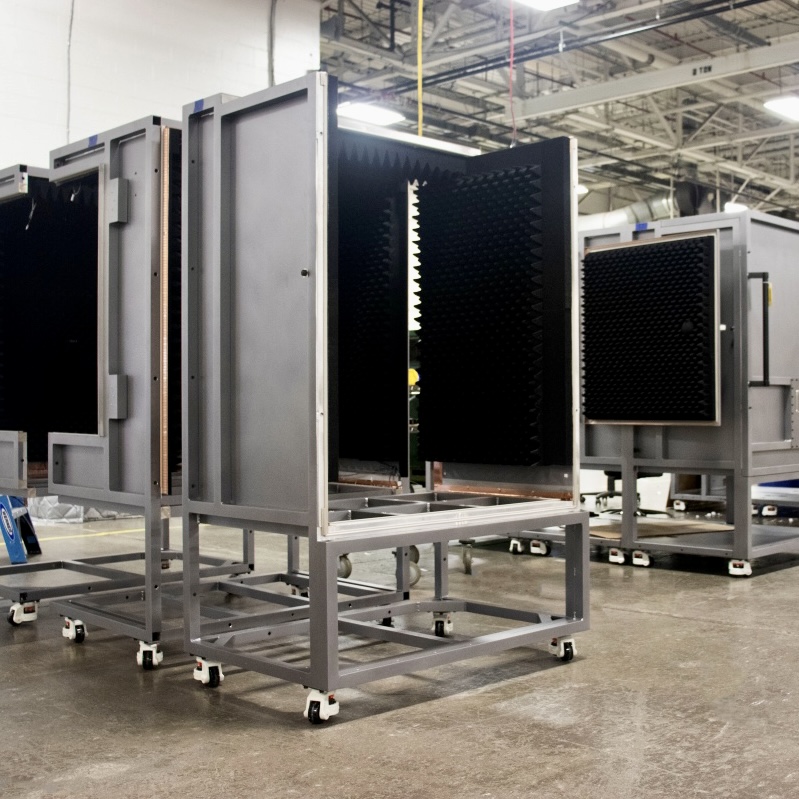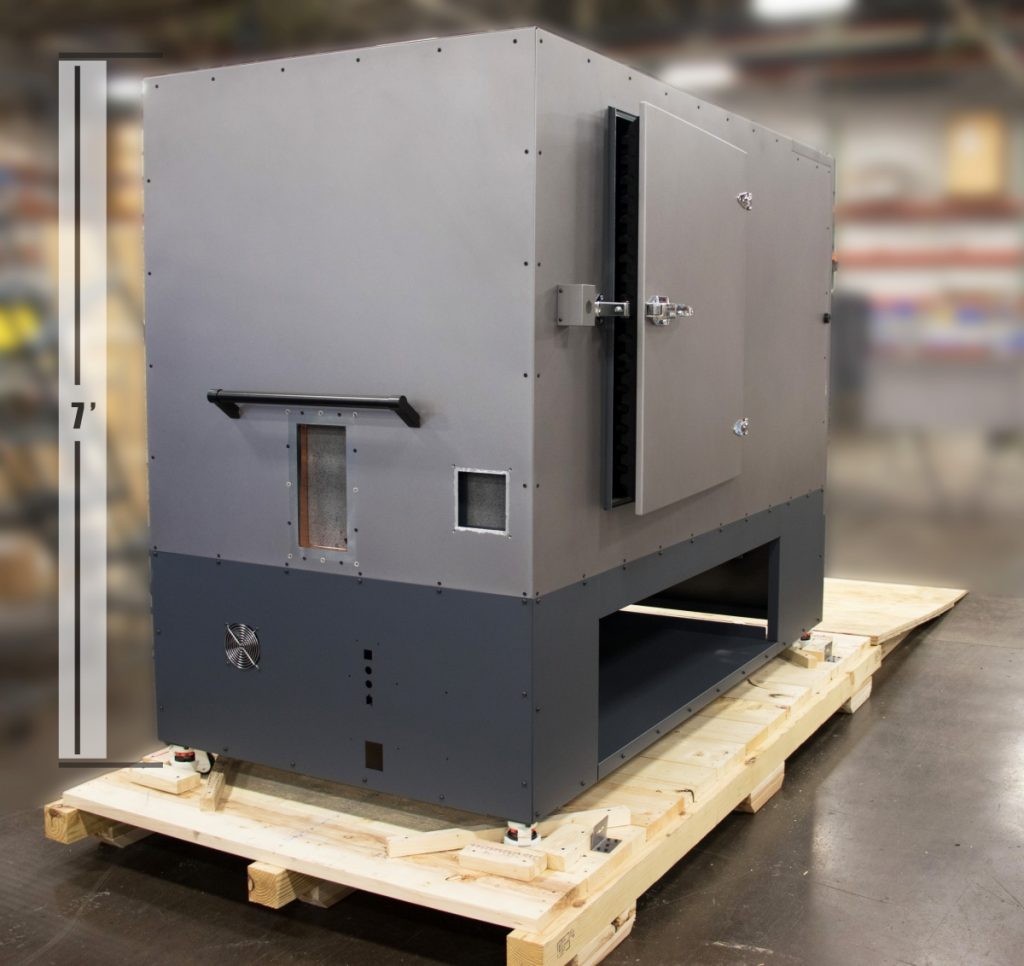Top 9 Metal Enclosure Manufacturer List and Guide
Top 9 Metal Enclosure Manufacturer Manufacturers & Suppliers List
1. Saginaw Control & Engineering – Steel Enclosures
Domain: saginawcontrol.com
Registered: 1997 (28 years)
Introduction: Saginaw Control & Engineering offers a variety of steel enclosures suitable for different environments and applications. The steel options include carbon steel, galvanized steel, and 304 or 316 stainless steel. The types of steel enclosures manufactured include: Operator System Enclosures, Wall-Mounted Enclosures, Free-Standing Enclosures, Floor-Mounted Enclosures, and Modular Enclosures. The encl…
2. HAMMFG – Electrical Enclosure Cabinets
Domain: hammfg.com
Registered: 1996 (29 years)
Introduction: Electrical Enclosure Cabinets include Mild Steel Enclosures (Type 12, 4), Stainless Steel Enclosures (Type 4X), Aluminum Enclosures (Type 4X), Non-Metallic Enclosures (Type 4X), Disconnect Enclosures, Modular Freestanding Enclosures, Operator Interface Enclosures, Wireway & Trough, Commercial Enclosures, Climate Control, Data Communication Infrastructure, and General Accessories. Enclosure sizes a…
3. Bull Metal Products – Custom Metal Enclosures
Domain: bullmetal.com
Registered: 1997 (28 years)
Introduction: Bull Metal Products specializes in custom design and manufacturing of metal enclosures, metal carts, metal bins, metal boxes, and metal cabinets for OEM manufacturers. They offer a variety of products including: 1. **First-Aid Kits** – Custom enclosures for various first aid kit sizes. 2. **Toolboxes** – High-quality custom metal tool cases and toolboxes. 3. **Industrial Carts** – Includes utility…
4. Andersen Industries – Custom-Made Sheet Metal Enclosures
Domain: andersenmp.com
Registered: 2000 (25 years)
Introduction: Custom-Made Sheet Metal Enclosures designed and manufactured by Andersen Industries. Key features include:
– Custom sizes ranging from 6″ square to 12 feet wide x 12 feet high x 50 feet long.
– Material options: carbon steel, galvanized steel, galvanneal, stainless steel (304 & 316), aluminum (5052 & 6061).
– Insulation options for sound attenuation and climate control.
– Access options: single/do…
5. Peko Precision – Custom Sheet Metal Enclosures
Domain: pekoprecision.com
Registered: 1998 (27 years)
Introduction: Custom sheet metal enclosure manufacturing services tailored to unique requirements. Capabilities include fabrication engineering assistance, detailed drawings, manufacturability enhancements, and cost-saving DFMA programs. Common fabrication techniques: laser cutting, CNC punching, forming & bending, precision welding, hardware insertion, and sheet metal assembly. Features include radius corners,…
6. Enclosure Manufacturers – Metal Enclosures
Domain: enclosuremanufacturers.com
Registered: 2001 (24 years)
Introduction: Metal enclosures are boxes, containers, and other fabricated shapes used to house, store, and enclose objects. Types of metal enclosures include stainless steel enclosures, aluminum enclosures, and electrical cabinets. They provide protection for sensitive equipment in various environments, including industrial settings. Metal enclosures can range from large housings for electrical substation equi…
7. Dalsin Industries – Custom Metal Enclosures
Domain: dalsinind.com
Registered: 1998 (27 years)
Introduction: Dalsin Industries specializes in custom metal enclosures, cabinets, chassis, and boxes for medium to high-volume fabrication. They manufacture products to protect sensitive equipment from harsh environments, dust, and moisture, offering NEMA enclosures. Key materials used include stainless steel, carbon steel (cold and hot rolled), aluminum, pre-primed, pre-painted, galvanized, galvaneal, aluminiz…
8. Newark – Metal Enclosures
Domain: newark.com
Registered: 1994 (31 years)
Introduction: This company, Newark – Metal Enclosures, is a notable entity in the market. For specific product details, it is recommended to visit their website directly.
9. Jameco – Industrial Electrical Enclosures
Domain: jameco.com
Registered: 1998 (27 years)
Introduction: Jameco offers a wide range of industrial electrical enclosures essential for protecting electrical components from environmental and mechanical threats. These enclosures are designed for secure mounting of switches, knobs, and displays, enhancing safety, durability, and performance in various applications such as manufacturing automation and renewable energy installations. The enclosures are made …
Introduction: Navigating the Global Market for metal enclosure manufacturer
In today’s competitive landscape, international B2B buyers face the critical challenge of sourcing reliable metal enclosure manufacturers that meet diverse industrial needs. Whether you are in Africa, South America, the Middle East, or Europe, understanding the intricacies of metal enclosures—from material selection to compliance with NEMA ratings—is essential for ensuring optimal performance and durability in your applications. This comprehensive guide is designed to navigate the global market for metal enclosures, providing insights into various types, applications, and key considerations for supplier vetting.
Buyers will find in-depth analyses of different enclosure materials such as mild steel, stainless steel, and aluminum, along with their respective advantages and best-use scenarios. Additionally, we will explore customization options, enabling businesses to tailor solutions that align with their specific operational requirements. The guide also addresses cost factors, helping you to make informed financial decisions without compromising on quality.
By empowering B2B buyers with actionable knowledge and strategic insights, this guide serves as an invaluable resource for sourcing metal enclosure manufacturers that not only meet your technical specifications but also support your long-term business objectives. With the right information at your fingertips, you can confidently navigate the complexities of the global market and ensure your projects succeed.
Understanding metal enclosure manufacturer Types and Variations
| Type Name | Key Distinguishing Features | Primary B2B Applications | Brief Pros & Cons for Buyers |
|---|---|---|---|
| Mild Steel Enclosures | Cost-effective, versatile, and suitable for indoor use | Manufacturing, Electrical, and HVAC systems | Pros: Affordable, readily available. Cons: Less corrosion-resistant. |
| Stainless Steel Enclosures | High corrosion resistance, durability, and aesthetic appeal | Food processing, pharmaceuticals, and outdoor installations | Pros: Long-lasting, hygienic. Cons: Higher cost, heavier. |
| Aluminum Enclosures | Lightweight, excellent thermal conductivity, and corrosion resistance | Telecommunications, aerospace, and automotive | Pros: Lightweight, easy to fabricate. Cons: More expensive than mild steel. |
| Custom Fabricated Enclosures | Tailored designs to meet specific requirements | OEMs across various industries | Pros: Exact fit for unique applications. Cons: Longer lead times, potential higher costs. |
| Modular Enclosures | Flexible designs that can be expanded or modified easily | Data centers, industrial automation | Pros: Scalable, adaptable. Cons: May require additional planning for integration. |
What Are Mild Steel Enclosures and Their Applications?
Mild steel enclosures are known for their affordability and versatility, making them ideal for general indoor applications. Commonly used in manufacturing and HVAC systems, these enclosures provide basic protection against dust and light moisture. When purchasing, buyers should consider the environment, as mild steel is less resistant to corrosion compared to other materials. They are a suitable choice for budget-conscious projects where extreme durability is not a primary concern.
Why Choose Stainless Steel Enclosures?
Stainless steel enclosures are characterized by their high resistance to corrosion and durability, making them suitable for demanding environments such as food processing and pharmaceuticals. These enclosures not only meet hygiene standards but also provide a sleek aesthetic for outdoor installations. Buyers should weigh the higher initial costs against the long-term benefits of durability and maintenance savings. They are an excellent investment for applications where exposure to harsh conditions is a factor.
How Do Aluminum Enclosures Stand Out?
Aluminum enclosures are favored for their lightweight properties and excellent thermal conductivity. They are commonly used in telecommunications, aerospace, and automotive sectors where weight reduction is critical. The corrosion resistance of aluminum makes it a reliable choice for outdoor applications. When considering aluminum enclosures, buyers should account for the higher costs and ensure that the design meets specific application needs. Their ease of fabrication allows for quick modifications when necessary.
What Are Custom Fabricated Enclosures?
Custom fabricated enclosures are designed specifically to meet the unique requirements of various applications. They are essential for Original Equipment Manufacturers (OEMs) who need tailored solutions for their products. While these enclosures provide the perfect fit, buyers should be prepared for potentially longer lead times and higher costs associated with custom designs. The investment can be justified by the enhanced functionality and performance that a bespoke solution offers.
What Benefits Do Modular Enclosures Provide?
Modular enclosures are designed for flexibility and scalability, allowing businesses to adapt their systems as needs change. Commonly used in data centers and industrial automation, these enclosures can be expanded or modified with relative ease. Buyers should consider the initial planning and integration processes involved, as they may require additional resources. The adaptability of modular enclosures can lead to long-term cost savings and improved operational efficiency, making them a strategic choice for growing businesses.
Key Industrial Applications of metal enclosure manufacturer
| Industry/Sector | Specific Application of metal enclosure manufacturer | Value/Benefit for the Business | Key Sourcing Considerations for this Application |
|---|---|---|---|
| Telecommunications | Custom enclosures for communication equipment | Protects sensitive equipment from environmental factors | Compliance with NEMA ratings, material durability |
| Renewable Energy | Enclosures for solar and wind energy systems | Ensures equipment longevity and optimal performance | Customization options, weather resistance |
| Industrial Automation | Control system enclosures for machinery | Enhances safety and operational efficiency | Precision manufacturing, custom sizes |
| Oil and Gas | Enclosures for hazardous area applications | Provides safety and regulatory compliance | Explosion-proof ratings, material selection for harsh environments |
| Medical Equipment | Enclosures for diagnostic and treatment devices | Protects sensitive medical equipment and ensures hygiene | Customization for specific equipment, easy access designs |
How Are Metal Enclosures Used in Telecommunications?
In the telecommunications sector, metal enclosures are vital for housing communication equipment, including routers, switches, and antennas. These enclosures protect sensitive electronics from dust, moisture, and physical damage, ensuring uninterrupted service. International buyers, particularly from regions with extreme weather, must consider NEMA ratings for environmental protection and select materials like stainless steel for corrosion resistance.
What Role Do Metal Enclosures Play in Renewable Energy?
Metal enclosures are crucial in renewable energy applications, such as solar panels and wind turbines, where they safeguard inverters and control systems. These enclosures help maintain optimal performance by shielding components from harsh weather conditions and environmental factors. Buyers need to evaluate customization options to fit specific equipment sizes and ensure that the materials used can withstand outdoor exposure, especially in regions with high humidity or temperature fluctuations.
How Are Metal Enclosures Essential for Industrial Automation?
In industrial automation, control system enclosures are essential for protecting machinery and electronic controls from environmental hazards. They enhance safety by preventing unauthorized access and reducing the risk of accidents. Companies sourcing these enclosures should prioritize precision manufacturing to meet specific dimensions and configurations, as well as explore options for additional features like climate control systems to ensure optimal functioning in diverse operational environments.
Why Are Metal Enclosures Critical in the Oil and Gas Industry?
The oil and gas sector requires robust enclosures to protect equipment used in hazardous areas. Metal enclosures must meet stringent safety regulations and provide explosion-proof ratings to prevent accidents in volatile environments. Buyers should focus on sourcing from manufacturers that offer materials specifically designed for harsh conditions, such as galvanized steel, and ensure compliance with relevant industry standards to mitigate risks effectively.
What Benefits Do Metal Enclosures Provide for Medical Equipment?
In the medical field, metal enclosures are used to house diagnostic and treatment devices, ensuring protection from contamination and physical damage. These enclosures are designed for easy access, allowing healthcare professionals to operate equipment efficiently while maintaining hygiene standards. When sourcing, international buyers should consider customization options to fit specific medical devices and ensure compliance with healthcare regulations, particularly in regions with varying standards.
3 Common User Pain Points for ‘metal enclosure manufacturer’ & Their Solutions
Scenario 1: Navigating Material Selection for Harsh Environments
The Problem: Many B2B buyers struggle with selecting the right material for metal enclosures, especially when operating in harsh environments like coastal areas or industrial settings. For instance, a manufacturer in Nigeria may need enclosures that withstand high humidity and saline conditions. The wrong choice can lead to corrosion, equipment failure, and ultimately, financial losses. Buyers often find themselves overwhelmed by the variety of materials available—such as stainless steel, aluminum, and carbon steel—and unsure of how to match the material to their specific application requirements.
The Solution: To effectively navigate material selection, buyers should engage in a thorough needs assessment before approaching manufacturers. This includes evaluating environmental conditions, regulatory requirements, and the intended use of the enclosure. For instance, specifying NEMA ratings can help clarify the necessary protection levels against environmental hazards. Buyers should consult with manufacturers who offer expertise in material science, as they can provide insights into the long-term performance of different materials. Additionally, leveraging resources such as material data sheets and case studies can guide informed decision-making. By opting for manufacturers that provide tailored advice based on comprehensive assessments, buyers can ensure they select the optimal material for their unique operational needs.
Scenario 2: Customization Challenges for Unique Applications
The Problem: B2B buyers often face difficulties when standard enclosures do not meet their specific requirements. For example, a telecommunications company in South America may require an enclosure that not only houses critical equipment but also integrates cooling systems to prevent overheating. Standard off-the-shelf products may lack the necessary features, leading to installation delays and increased costs. This scenario often leaves buyers feeling frustrated and uncertain about how to proceed with customization.
The Solution: To tackle customization challenges, buyers should work closely with manufacturers that specialize in bespoke solutions. Initiating a dialogue early in the design phase allows manufacturers to understand the specific requirements and constraints of the project. Buyers should present detailed specifications, including dimensions, material preferences, and any additional features such as ventilation or cable management systems. Some manufacturers offer a Customized Standard Enclosure (CSE) program, which enables buyers to modify existing designs to suit their needs without starting from scratch. This collaborative approach not only speeds up the design process but also ensures that the final product meets all operational criteria. Buyers can also request prototypes or samples to test before full-scale production, reducing the risk of costly mistakes.
Scenario 3: Ensuring Compliance with International Standards
The Problem: Compliance with international standards is a significant concern for B2B buyers, particularly when exporting products to different regions. For instance, a manufacturer in Europe may need to ensure that their metal enclosures comply with both local and international electrical safety standards. Non-compliance can result in delays, penalties, and reputational damage, making it crucial for buyers to understand the regulations governing their products.
The Solution: Buyers should prioritize manufacturers who are well-versed in international compliance standards, such as IEC, UL, and NEMA ratings. Conducting due diligence on a manufacturer’s certifications and past compliance records can provide reassurance regarding their capabilities. It’s advisable for buyers to create a checklist of applicable standards and share this with their chosen manufacturer during initial discussions. Furthermore, requesting detailed documentation that outlines compliance testing and certification processes can help buyers feel more confident in their purchase. Engaging in regular communication with the manufacturer throughout the production process ensures that compliance remains a priority and any potential issues are addressed promptly. By partnering with knowledgeable manufacturers who prioritize compliance, buyers can safeguard their products and streamline their market entry efforts.
Strategic Material Selection Guide for metal enclosure manufacturer
What Are the Key Properties of Common Materials Used in Metal Enclosures?
When selecting materials for metal enclosures, manufacturers often consider several factors such as durability, environmental resistance, and cost. Here, we analyze four common materials: mild steel, stainless steel, aluminum, and galvanized steel, focusing on their properties, advantages, disadvantages, and implications for international buyers.
How Does Mild Steel Perform as a Material for Metal Enclosures?
Mild steel is a versatile and cost-effective option for many applications. It typically offers good strength and is easy to work with, making it suitable for various enclosure types. However, it has lower corrosion resistance compared to other materials, which can be a significant drawback in humid or corrosive environments.
Pros:
– Cost-effective and widely available.
– High strength-to-weight ratio.
– Easy to fabricate and weld.
Cons:
– Prone to rust and corrosion without proper coating.
– Limited temperature resistance.
For international buyers, particularly in humid regions of Africa and South America, it is crucial to consider protective coatings such as powder coating or galvanization to enhance corrosion resistance.
What Advantages Does Stainless Steel Offer for Metal Enclosures?
Stainless steel, particularly grades 304 and 316, is renowned for its excellent corrosion resistance, making it ideal for harsh environments, including coastal areas. It can withstand higher temperatures and is less likely to suffer from rust, which is essential for long-term durability.
Pros:
– Exceptional corrosion resistance.
– High strength and durability.
– Aesthetic appeal for visible applications.
Cons:
– Higher cost compared to mild steel and aluminum.
– More complex manufacturing processes due to hardness.
International buyers must consider compliance with standards such as ASTM and DIN, especially in regions with stringent quality requirements. The initial investment may be higher, but the longevity of stainless steel enclosures can lead to cost savings over time.
Why Choose Aluminum for Metal Enclosures?
Aluminum is lightweight and offers good corrosion resistance, making it a popular choice for portable applications and environments where weight is a concern. It is also non-magnetic, which is beneficial for certain electronic applications.
Pros:
– Lightweight and easy to handle.
– Good corrosion resistance without additional coatings.
– Non-magnetic properties.
Cons:
– Lower strength compared to steel.
– More expensive than mild steel.
For international buyers, especially in the Middle East and Europe, aluminum enclosures can be a great choice for applications requiring mobility or where weight restrictions apply. However, buyers should be aware of the specific strength requirements for their applications.
What Is the Role of Galvanized Steel in Metal Enclosures?
Galvanized steel is mild steel that has been coated with a layer of zinc to improve corrosion resistance. This makes it a suitable option for outdoor applications where exposure to moisture is a concern.
Pros:
– Enhanced corrosion resistance compared to untreated mild steel.
– Cost-effective option for outdoor applications.
– Good strength and durability.
Cons:
– Limited aesthetic appeal due to the zinc coating.
– Can be prone to scratching, which may expose the underlying steel.
For international buyers, especially in regions like Africa and South America where outdoor applications are common, galvanized steel can provide a balance between cost and performance. Compliance with local standards for corrosion resistance is essential to ensure longevity.
Summary of Material Properties for Metal Enclosures
| Material | Typical Use Case for metal enclosure manufacturer | Key Advantage | Key Disadvantage/Limitation | Relative Cost (Low/Med/High) |
|---|---|---|---|---|
| Mild Steel | General-purpose enclosures | Cost-effective and widely available | Prone to rust without coatings | Low |
| Stainless Steel | Harsh environments, coastal applications | Exceptional corrosion resistance | Higher cost and complex manufacturing | High |
| Aluminum | Portable applications, electronics | Lightweight and good corrosion resistance | Lower strength compared to steel | Med |
| Galvanized Steel | Outdoor applications | Enhanced corrosion resistance | Limited aesthetic appeal | Low |
This guide provides a comprehensive overview of material selection for metal enclosures, helping international B2B buyers make informed decisions based on their specific application needs and regional considerations.
In-depth Look: Manufacturing Processes and Quality Assurance for metal enclosure manufacturer
What Are the Key Stages in the Manufacturing Process of Metal Enclosures?
Manufacturing metal enclosures involves several critical stages, each designed to ensure the final product meets rigorous quality and performance standards. Understanding these stages can help B2B buyers make informed decisions when selecting a supplier.
Material Preparation: How Is Raw Material Readied for Production?
The manufacturing process begins with material selection, where manufacturers typically choose from various metals such as mild steel, stainless steel, and aluminum. Each material is selected based on its intended application, environmental resistance, and cost considerations.
Once selected, materials undergo preparation processes like cutting and shearing to achieve the desired dimensions. Advanced technologies such as laser cutting and CNC machining are often employed for precision, ensuring that the components meet exact specifications.
Forming: What Techniques Are Used to Shape Metal Enclosures?
The forming stage involves shaping the prepared metal sheets into the desired enclosure design. Common techniques include bending, stamping, and deep drawing.
- Bending is frequently used to create flanges and edges, allowing for a more robust structure.
- Stamping involves pressing the metal into molds to produce detailed features like ventilation holes or mounting brackets.
- Deep drawing is used for creating deeper enclosures and complex shapes, which may be necessary for specific applications.
These processes are often aided by automated machinery, enhancing efficiency while maintaining high precision.
Assembly: How Are Components Brought Together?
Once individual components are formed, the assembly process begins. This stage may involve welding, riveting, or using screws and bolts to join parts together.
In the case of custom enclosures, manufacturers often provide additional options for assembly, including integration of electronic components or installing insulation materials. This flexibility can be crucial for clients requiring specific functionalities in their enclosures.
Finishing: What Finishing Techniques Are Commonly Applied?
The finishing stage is vital for both aesthetics and protection against environmental factors. Techniques such as powder coating, painting, or plating are commonly used to enhance durability and corrosion resistance.
Powder coating, in particular, is favored for its ability to provide a uniform finish and high resistance to wear and tear. Additionally, manufacturers often conduct surface treatments to prepare the metal for finishing, ensuring optimal adhesion and appearance.
What Quality Assurance Measures Are Implemented in Metal Enclosure Manufacturing?
Quality assurance (QA) is a cornerstone of the manufacturing process for metal enclosures. It ensures that the products not only meet design specifications but also comply with international and industry-specific standards.
What International Standards Should B2B Buyers Be Aware Of?
B2B buyers should be familiar with relevant international standards that govern manufacturing quality. The ISO 9001 standard is perhaps the most recognized, focusing on quality management systems and ensuring consistent product quality.
In addition to ISO standards, specific certifications may apply depending on the industry, such as CE marking for products sold in Europe or API standards for oil and gas applications. Understanding these standards can provide buyers with confidence in the quality and safety of the products.
What Are the Key Quality Control Checkpoints in the Manufacturing Process?
Quality control checkpoints are crucial for identifying defects and ensuring compliance throughout the manufacturing process. Common checkpoints include:
- Incoming Quality Control (IQC): This initial stage checks raw materials for quality and conformity to specifications before they enter the production line.
- In-Process Quality Control (IPQC): Conducted during the manufacturing process, IPQC monitors production stages to identify any deviations from standards, allowing for corrective actions to be taken promptly.
- Final Quality Control (FQC): The final inspection occurs before products are packaged and shipped. This stage typically includes functional testing and visual inspections to ensure that each enclosure meets the required specifications.
How Can B2B Buyers Verify a Supplier’s Quality Control Practices?
To ensure that a manufacturer adheres to quality standards, B2B buyers can take several steps:
- Audits: Conducting supplier audits is an effective way to assess a manufacturer’s quality control processes and adherence to standards. This involves reviewing documentation, inspecting facilities, and evaluating overall operations.
- Quality Reports: Requesting detailed quality assurance reports can provide insights into the manufacturing processes and any issues that have arisen during production.
- Third-Party Inspections: Engaging third-party inspection services can provide an unbiased assessment of the supplier’s quality management systems and products. These inspections can be particularly beneficial for international buyers who may not have direct oversight.
What Are the Challenges and Considerations for International Buyers?
International buyers, particularly from regions like Africa, South America, the Middle East, and Europe, may face unique challenges in sourcing metal enclosures. Understanding these nuances can help mitigate risks.
What Are the Regulatory and Compliance Nuances?
Different regions may have varying regulations and compliance requirements. For example, products exported to the European Union must meet CE marking regulations, while buyers in the Middle East may need to adhere to specific local standards. Buyers should ensure that their suppliers are knowledgeable about and compliant with these regulations.
How Do Cultural and Communication Differences Affect Supplier Relationships?
Cultural differences can impact negotiations, project timelines, and overall communication. Buyers should be aware of these potential barriers and consider partnering with suppliers who have experience in international trade and understand the cultural contexts of their clients.
What Logistics Considerations Should Be Accounted For?
Logistics can be a significant factor in international procurement. Buyers must consider shipping times, costs, and customs regulations, which can vary greatly depending on the origin and destination of the products. Establishing clear communication regarding timelines and expectations with suppliers is crucial for successful transactions.
In conclusion, understanding the manufacturing processes and quality assurance measures in the production of metal enclosures can significantly empower B2B buyers in making informed procurement decisions. By focusing on these aspects, buyers can better assess suppliers and ensure they receive products that meet their operational needs and compliance requirements.
Practical Sourcing Guide: A Step-by-Step Checklist for ‘metal enclosure manufacturer’
Introduction
Sourcing metal enclosures for your business is a critical process that requires careful consideration and planning. This guide provides a step-by-step checklist to help international B2B buyers effectively navigate the procurement of metal enclosure manufacturers. By following these steps, you can ensure that you select a supplier that meets your technical requirements, adheres to industry standards, and provides excellent service.
Step 1: Define Your Technical Specifications
Clearly outline your needs regarding size, material, and functionality. Different applications may require specific types of enclosures, such as NEMA-rated for environmental protection or custom designs for unique equipment. Establishing these specifications upfront helps streamline the search and ensures you communicate your requirements effectively to potential suppliers.
Step 2: Research Potential Suppliers
Conduct thorough research to identify manufacturers that specialize in the type of metal enclosures you need. Look for suppliers with a strong reputation in your industry and check their online presence for product catalogs, case studies, and customer testimonials. This will help you gauge their experience and reliability in delivering quality products.
Step 3: Evaluate Supplier Certifications
Verify that the manufacturers hold relevant certifications, such as ISO 9001 for quality management or NEMA standards for electrical enclosures. These certifications indicate that the supplier adheres to industry best practices and quality assurance processes. Additionally, inquire about their compliance with international regulations, especially if you are sourcing from different regions.
Step 4: Request Samples and Prototypes
Before making a bulk order, request samples or prototypes of the enclosures. This allows you to assess the quality, durability, and suitability of the products for your specific application. Look for manufacturers who can provide custom modifications to meet your precise requirements, ensuring that the final product aligns with your expectations.
Step 5: Assess Manufacturing Capabilities
Inquire about the manufacturing processes and technologies used by the supplier. Understanding their capabilities can help you determine if they can meet your volume needs and timelines. Ensure they have advanced equipment and skilled personnel to ensure precision and quality in the manufacturing of your enclosures.
Step 6: Check for After-Sales Support
Evaluate the level of customer service and after-sales support provided by the manufacturer. Reliable support can include assistance with installation, maintenance, and troubleshooting. A strong commitment to customer service indicates a manufacturer’s dedication to building long-term relationships and ensuring your satisfaction.
Step 7: Compare Pricing and Terms
Finally, obtain detailed quotes from multiple suppliers and compare pricing, payment terms, and delivery schedules. While cost is an important factor, consider the overall value, including quality and service. Choose a supplier that offers a competitive price without compromising on the quality of the enclosures or support.
By following this checklist, you can make informed decisions and establish successful partnerships with metal enclosure manufacturers that cater to your business needs.
Comprehensive Cost and Pricing Analysis for metal enclosure manufacturer Sourcing
What Are the Key Cost Components in Metal Enclosure Manufacturing?
When analyzing the cost structure of metal enclosure manufacturing, several components come into play. These include:
-
Materials: The choice of materials significantly impacts the overall cost. Common materials used include mild steel, stainless steel (304 and 316), and aluminum. Each material presents different cost implications, with stainless steel generally being more expensive due to its durability and corrosion resistance.
-
Labor: Labor costs encompass the wages of skilled workers, engineers, and quality control personnel. Labor costs can vary by region, often being lower in developing nations, which can be a consideration for international buyers.
-
Manufacturing Overhead: This includes costs associated with utilities, facility maintenance, and equipment depreciation. Efficient manufacturing processes can help mitigate these costs.
-
Tooling: Initial tooling costs for custom enclosures can be substantial. This includes molds, dies, and specialized machinery required for production. Custom designs typically require higher upfront investment but can lead to better product fit for specific applications.
-
Quality Control (QC): Ensuring that products meet industry standards often involves rigorous testing and inspection. The costs associated with QC can vary depending on the complexity and specifications of the enclosure.
-
Logistics: Shipping and handling costs can fluctuate based on distance, weight, and chosen Incoterms. For international shipments, customs duties and tariffs may also apply.
-
Margin: Manufacturers typically add a profit margin to cover risks and ensure sustainability. This margin can vary based on market conditions and competition.
How Do Price Influencers Affect Metal Enclosure Pricing?
Several factors can influence the pricing of metal enclosures, impacting what buyers ultimately pay:
-
Volume and Minimum Order Quantity (MOQ): Larger orders often attract discounts due to economies of scale. Understanding a manufacturer’s MOQ policy can help buyers strategize their purchasing to optimize costs.
-
Specifications and Customization: Highly customized enclosures tailored to specific applications generally incur additional costs. Buyers should weigh the benefits of customization against the increased expense.
-
Materials: The choice of materials not only affects the initial cost but also influences durability and maintenance expenses over the product’s lifespan. Investing in higher-quality materials can reduce long-term costs associated with repairs or replacements.
-
Quality Certifications: Enclosures that meet certain certifications (e.g., NEMA ratings) may carry a premium price. However, these certifications can provide assurance of quality and compliance with safety standards.
-
Supplier Factors: The reputation and reliability of the supplier can affect pricing. Established suppliers may charge more due to their track record of quality and service.
-
Incoterms: Understanding the implications of different Incoterms is crucial for international buyers. Terms like FOB (Free On Board) or CIF (Cost, Insurance, and Freight) can affect the final landed cost of products.
What Are Effective Buyer Tips for Negotiating Metal Enclosure Prices?
When sourcing metal enclosures, buyers can employ several strategies to enhance cost-efficiency:
-
Negotiate Terms: Don’t hesitate to negotiate pricing, especially for larger orders. Many manufacturers are open to discussions regarding volume discounts and payment terms.
-
Consider Total Cost of Ownership (TCO): Evaluate not just the purchase price but also the long-term costs associated with maintenance, repairs, and energy consumption. A slightly higher upfront cost may lead to savings over time.
-
Research and Compare Suppliers: Conduct thorough research to compare multiple suppliers. Look for those with a strong reputation and positive customer feedback, as this can save costs related to poor quality or service issues.
-
Be Aware of Pricing Nuances: International buyers should be mindful of currency fluctuations, import tariffs, and regional economic conditions that may affect pricing. Understanding these factors can lead to better purchasing decisions.
In conclusion, a comprehensive understanding of the cost structure and pricing influencers in metal enclosure manufacturing can empower buyers to make informed decisions, ultimately leading to more strategic sourcing and cost-effective solutions.
Alternatives Analysis: Comparing metal enclosure manufacturer With Other Solutions
Understanding Alternatives to Metal Enclosure Manufacturing
In the realm of industrial applications, metal enclosures serve a critical purpose in protecting sensitive electrical and electronic equipment. However, several alternatives exist that can offer similar benefits. This section will compare metal enclosure manufacturers against alternative solutions, highlighting key performance indicators that are crucial for B2B buyers across diverse international markets.
Comparison Table
| Comparison Aspect | Metal Enclosure Manufacturer | Alternative 1: Plastic Enclosures | Alternative 2: Composite Enclosures |
|---|---|---|---|
| Performance | High durability and strength, ideal for harsh environments | Moderate durability, suitable for less demanding applications | High strength-to-weight ratio, good for corrosion resistance |
| Cost | Generally higher due to material costs and manufacturing complexity | Lower initial costs, cost-effective for large-scale applications | Moderate, can vary based on material composition and processing |
| Ease of Implementation | Requires specialized knowledge for installation and customization | Easy to handle and install, lightweight | Moderate; may require specific tools for assembly |
| Maintenance | Low maintenance, resistant to environmental factors | Susceptible to UV degradation, may require more frequent checks | Generally low maintenance, but can be impacted by specific environmental conditions |
| Best Use Case | Industrial applications, outdoor installations, and extreme conditions | Consumer electronics, indoor settings, and light-duty applications | Marine environments, chemical handling, and applications requiring light weight |
Detailed Breakdown of Alternatives
What are the Advantages and Disadvantages of Plastic Enclosures?
Plastic enclosures are often chosen for their cost-effectiveness and lightweight nature. They are ideal for less demanding applications where high durability is not a primary concern. The ease of installation makes them appealing for projects with tight timelines. However, they may not perform well in extreme temperatures or harsh environments, leading to potential degradation over time. Their susceptibility to UV damage can also limit their effectiveness in outdoor applications.
Why Consider Composite Enclosures as an Alternative?
Composite enclosures present a middle ground between metal and plastic solutions. They offer a favorable strength-to-weight ratio and are resistant to corrosion, making them suitable for marine and chemical environments. Composite materials can withstand a range of temperatures, providing versatility in various applications. However, the initial investment might be higher than plastic enclosures, and the installation process can require more specialized tools or skills, which could complicate implementation.
How to Choose the Right Solution for Your Needs
When selecting the right enclosure solution, B2B buyers should consider their specific requirements, including the operational environment, budget constraints, and the level of protection needed for their equipment. Metal enclosures remain a strong choice for high-performance applications, especially in industries that demand durability and reliability. However, plastic and composite alternatives can provide viable solutions depending on the use case and cost considerations. Conducting a thorough analysis of your operational needs and potential trade-offs will ensure you make an informed decision that aligns with your business objectives.
Essential Technical Properties and Trade Terminology for metal enclosure manufacturer
What Are the Key Technical Properties of Metal Enclosures?
When selecting metal enclosures for various applications, understanding the technical specifications is crucial for ensuring that the product meets operational demands and regulatory standards. Here are some essential properties to consider:
-
Material Grade
The choice of material significantly influences the durability and performance of metal enclosures. Common materials include mild steel, stainless steel (304, 316 grades), and aluminum. Mild steel offers strength and cost-effectiveness, while stainless steel provides corrosion resistance essential for harsh environments. Aluminum is lightweight and suitable for applications where weight savings are critical. -
NEMA Rating
The National Electrical Manufacturers Association (NEMA) rating defines the enclosure’s ability to protect electrical components from environmental hazards. Different ratings (e.g., NEMA 1, 3, 4, 4X, 12) indicate varying levels of protection against dust, water, and corrosive elements. For international buyers, understanding these ratings is essential for compliance with local safety standards and regulations. -
Tolerance and Dimensions
Precise tolerances are vital for ensuring that enclosures fit correctly with other components. Tolerances indicate the allowable deviation from specified dimensions, which can affect assembly and installation processes. Dimension specifications (height x width x depth) need to be clearly stated to avoid miscommunication, particularly in B2B transactions where custom sizes may be required. -
Finish and Coating
The surface finish of metal enclosures impacts both aesthetics and functionality. Common finishes include powder coating, galvanization, and anodizing. These coatings not only enhance appearance but also provide protection against corrosion and wear, extending the lifespan of the enclosure. Buyers should specify finish requirements to ensure product longevity and suitability for specific environments. -
Load Capacity
Load capacity refers to the maximum weight or stress that an enclosure can handle without compromising its structural integrity. This is particularly important for enclosures used in industrial settings where heavy equipment may be mounted. Understanding load capacity helps in selecting the right enclosure for specific applications and ensures safety and reliability. -
Thermal Management
Effective thermal management is crucial in applications where enclosures house electronic components that generate heat. Buyers should consider features such as ventilation, heat sinks, or cooling fans that may be integrated into the design. Proper thermal management prevents overheating and enhances the performance and lifespan of the enclosed equipment.
What Are Common Trade Terms Used in Metal Enclosure Manufacturing?
Familiarity with industry terminology is essential for effective communication and negotiation in B2B transactions. Here are some common terms that buyers should know:
-
OEM (Original Equipment Manufacturer)
OEM refers to a company that manufactures products that are sold under another company’s brand. In the context of metal enclosures, OEMs often require custom designs tailored to their specific needs. Understanding OEM relationships can help buyers align their requirements with the capabilities of manufacturers. -
MOQ (Minimum Order Quantity)
MOQ is the smallest quantity of a product that a supplier is willing to sell. This term is significant for international buyers who may be concerned about inventory costs and storage. Knowing the MOQ helps in budgeting and planning for large-scale projects. -
RFQ (Request for Quotation)
An RFQ is a formal document requesting pricing and terms from suppliers for specific products or services. This is a critical step in the procurement process, allowing buyers to compare costs and options across different manufacturers. A well-prepared RFQ can streamline negotiations and ensure transparency. -
Incoterms (International Commercial Terms)
Incoterms are a set of international trade terms that define the responsibilities of buyers and sellers in shipping and delivery. Understanding these terms, such as FOB (Free On Board) or CIF (Cost, Insurance, and Freight), is crucial for international transactions to clarify who bears the risk and costs at various stages of transport. -
Customization
Customization refers to the ability to modify standard products to meet specific requirements. In the metal enclosure industry, this could include altering dimensions, materials, finishes, or additional features. Buyers should inquire about customization options to ensure that the final product fits their unique application needs.
By comprehensively understanding these technical properties and industry terms, B2B buyers can make informed decisions, ensuring that the metal enclosures they procure meet their operational requirements and comply with industry standards.
Navigating Market Dynamics and Sourcing Trends in the metal enclosure manufacturer Sector
What Are the Current Market Dynamics and Key Trends in the Metal Enclosure Manufacturing Sector?
The metal enclosure manufacturing sector is influenced by several global drivers, including the rapid growth of the electronics and telecommunications industries, urbanization, and increasing infrastructure investments in emerging markets. For international B2B buyers, particularly from regions like Africa, South America, the Middle East, and Europe, understanding these dynamics is essential. The demand for robust, reliable, and versatile metal enclosures is rising as businesses seek to protect sensitive equipment against environmental factors and security threats.
Current trends indicate a shift towards customization and flexibility in sourcing strategies. Manufacturers are increasingly adopting advanced technologies, such as automation and IoT, to enhance production efficiency and product quality. This technological evolution allows for more precise and tailored solutions, catering to specific industry requirements. Additionally, the integration of digital platforms for procurement is becoming a standard practice, enabling buyers to easily compare options, request quotes, and manage supply chain logistics more effectively.
Emerging markets are particularly dynamic, with significant investments in telecommunications and renewable energy sectors driving demand for specialized enclosures. Buyers in regions like Nigeria and Vietnam should be aware of local regulations and certifications that may affect sourcing decisions, ensuring compliance while maximizing operational efficiency.
How Important Is Sustainability and Ethical Sourcing in the Metal Enclosure Sector?
Sustainability is no longer a mere trend; it has become a fundamental aspect of B2B operations in the metal enclosure manufacturing sector. The environmental impact of metal production is significant, prompting manufacturers to adopt sustainable practices. This includes sourcing raw materials responsibly and minimizing waste through recycling and reusing processes.
For B2B buyers, understanding the importance of ethical supply chains is crucial. Many manufacturers are pursuing certifications such as ISO 14001, which focuses on effective environmental management systems. Buyers should prioritize suppliers who can demonstrate their commitment to sustainability through transparent practices and certifications.
Moreover, the use of green materials—such as recyclable metals and eco-friendly coatings—can enhance the product’s appeal and compliance with environmental regulations. This not only reflects positively on the buyer’s corporate social responsibility efforts but also aligns with the growing consumer preference for sustainable products, ultimately influencing purchasing decisions across various sectors.
What is the Brief History and Evolution of the Metal Enclosure Manufacturing Sector?
The metal enclosure manufacturing sector has evolved significantly since its inception in the mid-20th century. Initially, the focus was primarily on basic protective enclosures for electrical equipment. However, as technology advanced, the demand for more sophisticated solutions grew, leading to the development of specialized enclosures designed for various applications, including telecommunications, industrial automation, and data centers.
Over the decades, innovations in materials and manufacturing processes have transformed the industry. The introduction of advanced steel alloys and aluminum has enhanced durability and corrosion resistance, while modern fabrication techniques, such as laser cutting and CNC machining, have improved precision and customization capabilities. Today, manufacturers are not only tasked with creating protective solutions but also with integrating smart technology and sustainable practices into their offerings, reflecting the sector’s ongoing evolution in response to market demands and technological advancements.
Frequently Asked Questions (FAQs) for B2B Buyers of metal enclosure manufacturer
-
1. How do I choose the right material for my metal enclosure needs?
Selecting the appropriate material for your metal enclosure depends on the specific environmental conditions and application requirements. Common options include mild steel for general use, stainless steel for corrosion resistance, and aluminum for lightweight applications. Evaluate factors such as exposure to chemicals, moisture levels, and temperature fluctuations. Consulting with manufacturers can provide insights into which material will best meet the NEMA ratings and durability standards required for your project. -
2. What customization options are available for metal enclosures?
Most metal enclosure manufacturers offer a range of customization options, including size, shape, material type, and additional features like ventilation, locks, and paint finishes. Some manufacturers provide a Customized Standard Enclosure (CSE) program or fully custom designs to meet unique specifications. It’s essential to communicate your requirements clearly to the manufacturer to ensure that the final product aligns with your operational needs. -
3. What are the minimum order quantities (MOQ) for metal enclosures?
Minimum order quantities can vary significantly between manufacturers and depend on the type of enclosure required. While some manufacturers may have a low MOQ for standard products, custom enclosures often have higher MOQs due to the specialized manufacturing processes involved. It’s advisable to discuss your project needs with potential suppliers to understand their MOQs and explore options that fit your budget and timeline. -
4. How can I ensure quality assurance when sourcing metal enclosures?
To ensure quality assurance, request certifications and compliance documentation from manufacturers, such as ISO 9001, which indicates adherence to quality management standards. Ask for samples or prototypes to evaluate the craftsmanship and materials used. Additionally, review customer testimonials and case studies to gauge the manufacturer’s reliability and quality track record before finalizing your partnership. -
5. What payment terms should I expect when ordering metal enclosures internationally?
Payment terms can vary by manufacturer and region, but common practices include upfront deposits (often 30-50%) followed by payment upon delivery or a letter of credit for larger orders. Ensure that you discuss payment options, currency, and potential fees upfront to avoid surprises. Also, consider using secure payment methods that provide buyer protection during international transactions. -
6. How do I navigate logistics and shipping for international metal enclosure orders?
When ordering internationally, work closely with your manufacturer to understand shipping options and associated costs. Discuss the Incoterms (International Commercial Terms) that will govern the shipping process, such as FOB (Free on Board) or CIF (Cost, Insurance, and Freight). Ensure that you are aware of customs regulations and duties in your country to avoid delays and additional charges upon arrival. -
7. What should I consider when vetting potential metal enclosure suppliers?
When vetting suppliers, assess their manufacturing capabilities, experience in your industry, and reputation in the market. Request references from previous clients and inquire about their production processes and lead times. Additionally, consider their ability to provide support for customization and their responsiveness to inquiries. A thorough evaluation can help ensure you choose a reliable partner. -
8. How can I ensure compliance with international standards when sourcing metal enclosures?
To ensure compliance with international standards, confirm that the manufacturer adheres to relevant certifications such as NEMA (National Electrical Manufacturers Association) ratings, CE marking for European standards, or UL (Underwriters Laboratories) certification. Request documentation demonstrating compliance and assess the manufacturer’s commitment to quality control processes. This diligence will help mitigate risks associated with non-compliance in your market.
Important Disclaimer & Terms of Use
⚠️ Important Disclaimer
The information provided in this guide, including content regarding manufacturers, technical specifications, and market analysis, is for informational and educational purposes only. It does not constitute professional procurement advice, financial advice, or legal advice.
While we have made every effort to ensure the accuracy and timeliness of the information, we are not responsible for any errors, omissions, or outdated information. Market conditions, company details, and technical standards are subject to change.
B2B buyers must conduct their own independent and thorough due diligence before making any purchasing decisions. This includes contacting suppliers directly, verifying certifications, requesting samples, and seeking professional consultation. The risk of relying on any information in this guide is borne solely by the reader.
Strategic Sourcing Conclusion and Outlook for metal enclosure manufacturer
As the global demand for high-quality metal enclosures continues to rise, strategic sourcing becomes increasingly vital for international B2B buyers. Understanding the diverse range of materials—such as mild steel, stainless steel, and aluminum—enables buyers to select the most suitable options tailored to specific environmental needs and applications. Collaborating with manufacturers that offer customization options can lead to significant advantages, ensuring that products meet unique operational requirements while adhering to industry standards.
Moreover, leveraging advanced technologies in manufacturing processes can enhance product durability and efficiency, ultimately leading to cost savings in the long run. By prioritizing suppliers who demonstrate a commitment to quality and compliance, buyers can mitigate risks associated with supply chain disruptions and subpar products.
Looking ahead, the metal enclosure market is poised for growth, particularly in emerging markets across Africa, South America, the Middle East, and Europe. As these regions continue to develop, the demand for reliable and innovative solutions will only increase. Now is the time for international B2B buyers to engage with reputable manufacturers and explore strategic partnerships that will drive success in their projects. Embrace the opportunity to elevate your sourcing strategy and secure a competitive edge in the evolving landscape of metal enclosure solutions.
